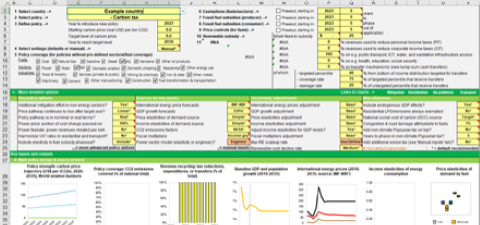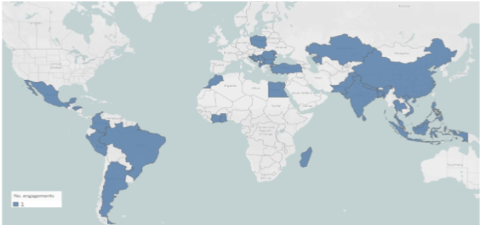Climate change threatens to erode decades of development progress. As a response, 196 countries adopted the Paris Agreement to transition to “net-zero” global emissions by mid-century and, thereby, limit global warming to well below 2 degrees Celsius compared to pre-industrial levels. However, with GHG emissions continuing to increase, countries are not yet on track (IPCC, 2023).
Large gaps in environmental taxation persist globally. In 2022 governments spent a record USD 1 trillion, or 1% of global GDP on fossil fuel subsidies and tax expenditures. Furthermore, when accounting for implicit subsidies (i.e., when the retail price fails to include external costs), the IMF estimates that the tax gap represents 6.8 percent of GDP in the average country (Parry et al., 2021). While 23% of global greenhouse gas (GHG) emissions are now covered by 68 explicit carbon pricing instruments, most carbon prices remain inefficiently low (World Bank, 2022). 60% of carbon emissions from energy use in 44 OECD and G20 countries are neither covered by fuel taxes nor by carbon pricing instruments (OECD, 2021). However, not only do direct carbon prices remain below their desired range to internalize the social costs of carbon but also global fossil fuel subsidies continue to place a negative indirect price on carbon emissions (World Bank, forthcoming) and are far from decreasing. According to joint OECD-IEA estimates, support for fossil fuels in 51 countries worldwide almost doubled to 697.2 USD billion in 2021 from 362.4 USD billion in 2020 (OECD and IEA, 2022).
Green taxes or fossil fuel subsidy reforms are urgent and can help countries raise revenues at lower cost than other conventional taxes (see, for example, Schoder, 2022), while accelerating investments in renewables. However, the misleading idea that decarbonization conflicts with economic growth and the lack of knowledge for best-practice policy design have resulted in insufficient action on climate.
Nonetheless, co-benefits resulting from timely taxation reforms overweight the cost of inaction (see, for example, Scovronick et al 2019; Markandya et al 2019; Weitzel et al 2019; Rauner et al 2020; Vandyck et al 2018b) . In particular, to induce this transformation while safeguarding economic development, most economists point to tax reforms as a key policy instrument:
- Environmental taxation can contribute to multiple Sustainable Developing Goals (SDGs). Environmental tax reforms can have multiple co-benefits beyond climate (Heine and Black, 2019). For example, the reduction in fossil fuel consumption induced by excise taxes on fuels or carbon reduces local air pollution, contributing to SDG3 (Good Health and Well-Being and SDG15 on Life and Land). Similarly, there is evidence of the effectiveness of gasoline taxes in controlling the growth of motor transport, reducing road congestion and road accidents; thus, supporting SDG11 (Sustainable Cities and Communities). There is increasing evidence, too, that environmental taxes can raise revenue at lower costs to the economy than some conventional taxes. For example, using taxes on carbon and fuel instead of payroll taxes can reduce the shadow economy and support formal employment, influencing SDG8 (Decent work and Economic Growth).
- Environmental taxes improve the efficiency of domestic resource mobilization. Countries pioneering these reforms have found that environmental taxes can generate substantial revenues, even in the medium term. They can do so while increasing economic efficiency: they incorporate social costs into product prices, using the power of the private market for reducing these problems. There is also rising evidence that environmental taxes contract output and employment less than conventional ones – especially in developing countries (Schroder, 2022; Burns et al, 2021, Timilsina et al, 2021). Another factor is the interplay with expenditure policy. In many countries, rising environmental problems exacerbate the need for additional government expenditures. Spending on environmental clean-up is important but over-relying on public expenditures in addressing social costs can worsen already strained fiscal space and put further pressure on raising conventional taxes. This is where environmental taxes help mobilize private-sector solutions. Environmental taxes, thus, create a triple win for fiscal policy: the revenue generated, the efficiency improvements to the tax system, and the reduction in the need for raising conventional taxes to finance public expenditures for addressing the same social costs.
- Environmental taxes can help developing countries cost-effectively achieve low-carbon transformation while supporting an inclusive and equitable growth pathway. Particularly in lower-income countries, environmental fiscal reforms can be pro-poor and improve equality (SDG1 & SDG 10). Firstly, this is because richer, urban households tend to have more energy-intensive lifestyles (Dorband et al, 2019) and, secondly, because the structural change induced by environmental taxes can increase the labor intensity of production (Wiebe and Malerba 2021, ILO and IDB, 2020) raising the relative return to labor (Goulder et al 2019, Timilsina et al 2021). If revenues are used to improve access to core infrastructure, this progressivity can be further strengthened, particularly benefitting poor, rural households (Dorband et al, 2022).


